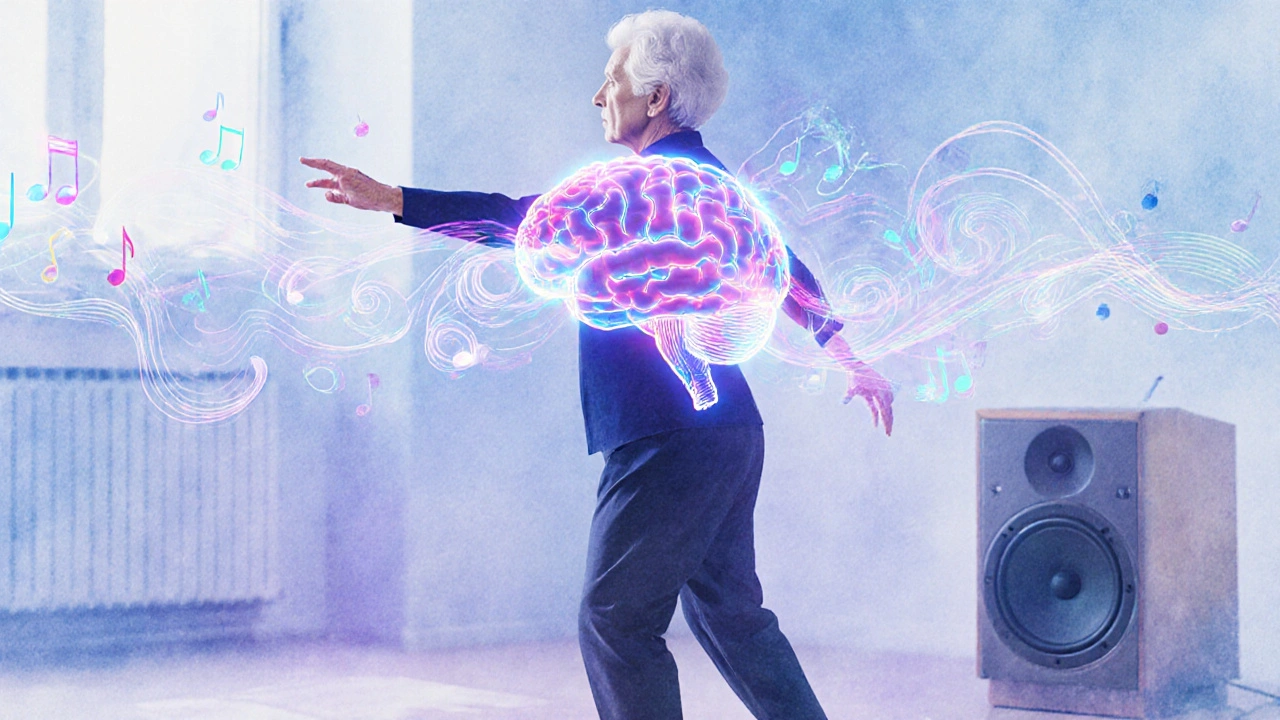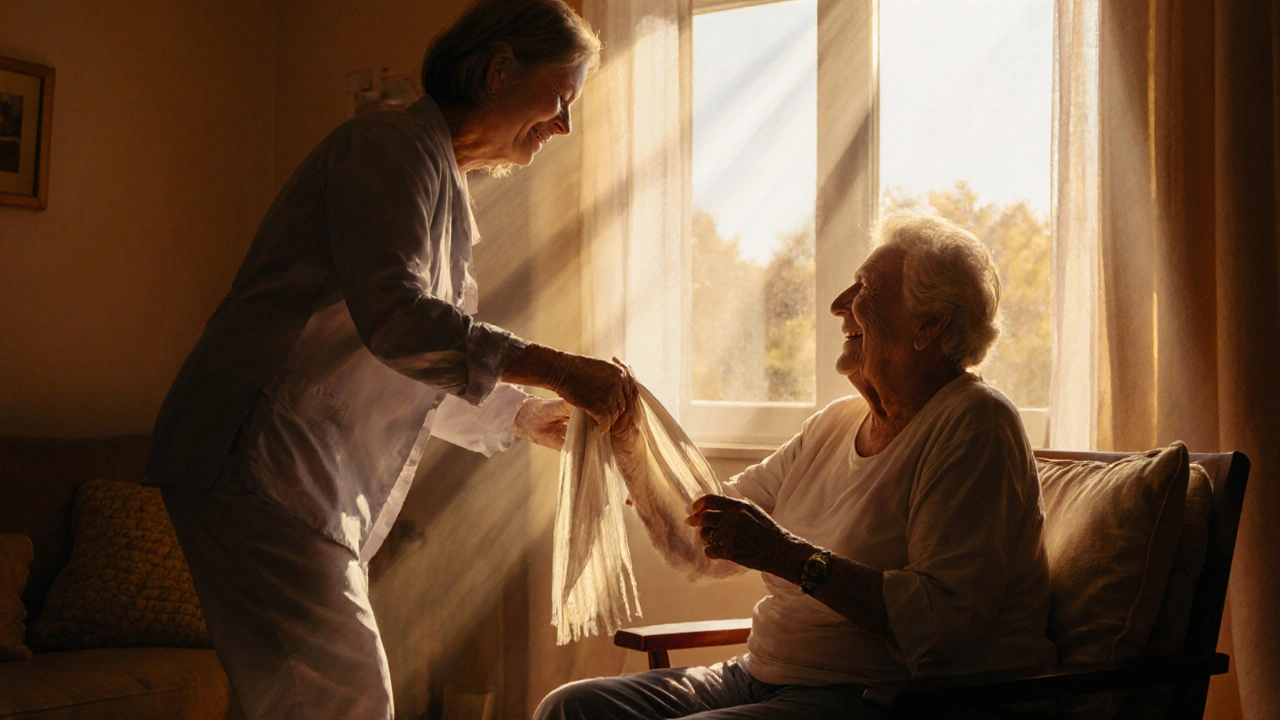Dementia Therapy Benefit Estimator
Estimate potential benefits based on research from the 2023 Australian study of seniors with mild-to-moderate dementia. Results are indicative and should be discussed with healthcare professionals.
How Often Do You Plan to Practice?
How Long Are Sessions?
Participant Severity
When dementia starts to cloud memory and movement, families look for gentle ways to keep connections alive. dance therapy and its broader cousin, movement therapy, have emerged as low‑stress, high‑reward options that address both mind and body.
What Is Dementia and Why Movement Matters?
Dementia is a progressive loss of cognitive abilities that affects memory, reasoning, and daily functioning. As the brain’s neural pathways weaken, staying physically active can stimulate the remaining circuits and slow decline.
Research links regular Physical Activity to improved blood flow, reduced inflammation, and better mood in older adults. That’s why clinicians are turning to rhythmic, social forms of exercise.
Defining Dance Therapy and Movement Therapy
Dance Therapy is a structured therapeutic approach that uses dance movements to promote physical, emotional, and cognitive health. Practitioners combine music, guided choreography, and improvisation to engage participants in a safe, supportive environment.
Movement Therapy broadens the concept to include any therapeutic work that uses intentional body motion-such as tai‑chi, gentle stretching, or guided walking-to achieve similar outcomes.
Both modalities share a core belief: the body remembers what words cannot, making them ideal for people whose verbal abilities are fading.
Cognitive Benefits: Boosting Memory and Attention
When a person with dementia follows a simple dance sequence, the brain must coordinate rhythm, spatial awareness, and timing. This multi‑sensory challenge lights up the prefrontal cortex and the hippocampus-areas crucial for memory.
Cognitive Function refers to the mental processes of thinking, learning, remembering, and problem‑solving. In a 2023 Australian study of 78 seniors with mild‑to‑moderate dementia, participants who attended twice‑weekly dance sessions for six months showed a 15% improvement in standard memory tests compared to a control group.
The concept of Neuroplasticity is the brain’s ability to reorganize and form new neural connections. Repetitive rhythmic movement encourages neuroplastic rewiring, giving remaining neurons a chance to pick up new tasks.

Emotional and Mood Advantages
Music and movement trigger the release of endorphins and serotonin, chemicals that lift mood and lessen anxiety. Participants often report feeling “lighter” after a session.
Mood describes the prevailing emotional state, ranging from happiness to irritability. A 2022 pilot in Melbourne recorded a 30% drop in depressive scores among residents who engaged in weekly dance therapy for three months.
Beyond chemicals, the act of expressing emotions through movement provides a non‑verbal outlet for frustration, fear, or grief-especially valuable when language becomes limited.
Social Interaction and Caregiver Support
Group sessions turn a therapeutic activity into a social event. Shared laughter and eye contact foster a sense of belonging.
Social Interaction is the exchange of thoughts, feelings, or behaviors between individuals. Regular group dancing can reduce feelings of isolation, a known risk factor for accelerated cognitive decline.
For Caregiver, witnessing a loved one move with joy eases caregiving stress. Caregivers who participate alongside patients report increased patience and reduced burnout.
How to Implement a Dance or Movement Program
- Assess Safety: Consult a physician to confirm the participant can stand, balance, and follow simple cues.
- Choose the Right Music: Opt for familiar, slow‑tempo songs that encourage natural steps. Classics from the 1960s‑70s are often well‑received.
- Start Simple: Begin with seated movements-arm lifts, shoulder rolls, foot taps-before progressing to standing.
- Keep Sessions Short: 20‑30 minutes is enough to stimulate without tiring.
- Use Visual Cues: Demonstrate each step, then let participants mirror the motion.
- Encourage Expression: Allow improvisation; there’s no “wrong” way to move.
- Monitor Progress: Record observations on mood, memory recall, and physical stamina after each session.
Community centers, memory clinics, and even home settings can host these activities. Many Australian aged‑care providers now offer weekly “Movement Moments” led by accredited dance therapists.

Comparison with Traditional Therapies
| Benefit Area | Dance/Movement Therapy | Traditional Cognitive Therapy |
|---|---|---|
| Physical Mobility | Improves balance and joint flexibility | Minimal impact |
| Emotional Well‑being | Elevates mood via music and expression | Relies on talk‑back strategies |
| Social Engagement | Group dance fosters connection | Often one‑on‑one |
| Neuroplastic Stimulation | Multisensory coordination drives neural growth | Focused mental exercises only |
| Implementation Ease | Low equipment, adaptable to any space | Requires specialized cognitive materials |
The table shows why many care facilities are adding dance to their therapeutic mix-it delivers a broader range of benefits without demanding costly resources.
Common Concerns and How to Address Them
- “My loved one can’t follow instructions.” Start with seated clapping or simple foot taps; rhythm is easier to grasp than precise steps.
- “Will it cause falls?” Supervise closely, use sturdy chairs, and keep a clear floor area. Gradual progression reduces risk.
- “Is this just entertainment?” While fun, the structured nature of therapy-goal‑setting, observation, feedback-makes it a clinical intervention.
- “Do I need a certified therapist?” For safety and best outcomes, a professional trained in dance movement therapy is ideal, though community volunteers can assist under guidance.
Frequently Asked Questions
Can dance therapy work for severe dementia?
Even in advanced stages, simple rhythmic movements can stimulate sensory pathways and improve mood. The focus shifts from cognitive goals to comfort and connection.
How often should sessions be held?
Two to three times per week, each lasting 20‑30 minutes, offers enough repetition to build neural pathways without causing fatigue.
What music genres are most effective?
Familiar, melodic tunes with a steady beat-classic pop, folk, or even instrumental jazz-tend to resonate best, as they trigger autobiographical memories.
Do I need special equipment?
Not really. A sturdy chair, a clear floor, and a sound system are enough. Props like scarves or lightweights can add variety.
Is there evidence that these benefits last?
Longitudinal studies in Australia and the UK show that participants who maintain regular dance routines retain higher scores on memory and mood scales for up to two years compared to non‑participants.
In short, dance and movement therapy give dementia patients a chance to move, remember, and smile-all while keeping caregivers a little more hopeful. If you’re considering adding this to a care plan, start small, stay consistent, and let the rhythm guide the healing.




Suzanne Podany
If you're looking for a gentle way to keep a loved one engaged, introducing simple seated rhythms can spark memory recall and lift mood without overwhelming the senses.
Sunil Kamle
One might observe, with great enthusiasm, that the purported benefits of dance therapy are presented as a panacea, yet the underlying studies are often modest in scope and fraught with methodological limitations.
Steve Helsel
This sounds like another fad that overpromises and underdelivers.
Steve Moody
The therapeutic potential of rhythmic movement for individuals with neurocognitive decline is, without exaggeration, a subject worthy of scholarly attention. Indeed, the literature cited in the article aligns with a growing body of evidence that suggests multisensory engagement can facilitate neuroplastic reorganization. When participants synchronize their motor outputs to an auditory stimulus, the cortico‑striatal loops receive amplified dopaminergic input, which-according to contemporary neurophysiological models-may bolster hippocampal encoding processes. Moreover, the social dimension inherent in group dance introduces a layer of affective resonance, thereby activating the limbic circuitry associated with reward and motivation. From a clinical perspective, the modest yet statistically significant improvements in memory scores observed after a six‑month protocol are, admittedly, encouraging, though one must remain vigilant against overstating causality. It is also crucial to distinguish between transient elevations in mood, mediated by endorphin release, and sustained cognitive gains that persist beyond the immediate intervention window. Practitioners should, therefore, implement longitudinal follow‑up assessments to parse out the durability of therapeutic effects. In addition, the dosage parameters-twice weekly sessions of twenty‑to‑thirty minutes-appear to strike an optimal balance between neurostimulation and fatigue avoidance. Any deviation toward excessive frequency risks inducing musculoskeletal strain, which could paradoxically diminish adherence and negate the intended benefits. Equally, insufficient exposure may fail to generate the repetitive motor learning necessary for synaptic strengthening. Consequently, a calibrated regimen that integrates progressive complexity, while respecting individual functional thresholds, is paramount. From an operational standpoint, the minimal equipment requirements render dance therapy an accessible modality for community‑based settings, a point often underappreciated in cost‑effectiveness analyses. Nonetheless, the importance of qualified facilitators-ideally certified in dance movement therapy-cannot be overstated, as their expertise ensures safety, cultural relevance, and therapeutic fidelity. In practice, integrating familiar musical repertoires, such as mid‑century popular standards, can further augment autobiographical memory retrieval, thereby enriching the cognitive stimulus. Finally, the interdisciplinary collaboration between neurologists, occupational therapists, and dance artists embodies the holistic ethos that modern dementia care strives to achieve. In sum, while the preliminary data are promising, rigorous randomized controlled trials with larger cohorts remain indispensable to substantiate the mechanistic hypotheses presented herein.
Adrian Hernandez
While the article paints a hopeful picture, one can't help noticing that the funding sources and the very institutions promoting dance therapy have a vested interest in expanding the market for wellness programs, which raises questions about the impartiality of the cited data.
Geneva Lyra
I think its great that community centres are open to try new things. This can help seniors feel more conected and lighthened day‑to‑day, and the low‑impact nature of the movements makes it safe for most participants.
Moritz Bender
The protocol you outlined aligns with current neurorehabilitation frameworks, specifically the concept of activity‑dependent synaptic plasticity, and incorporating proprioceptive cues can further enhance cortical remapping :) . Moreover, employing standardized outcome measures such as the MoCA and GDS ensures quantifiable tracking of cognitive and affective trajectories.
Nicole Hernandez
It is encouraging to see evidence supporting multimodal interventions, and the recommendation of familiar music selections adds a culturally resonant element that may facilitate autobiographic memory retrieval.
florence tobiag
Nevertheless, one must consider the possibility that the so‑called “benefits” are simply a by‑product of increased social interaction-an effect that could be achieved through any low‑cost group activity; the emphasis on dance may therefore be a convenient narrative to commercialize an otherwise trivial phenomenon.
Terry Washington
It is morally indefensible to ignore the profound suffering of dementia patients by relegating them to passive existence; embracing dance therapy is not merely an optional enrichment but an ethical imperative that reaffirms their intrinsic dignity and humanity.
Claire Smith
While the ethical appeal is noted, the practical implementation of such programs must confront resource constraints, staffing shortages, and the variability of patient responsiveness, factors that are often glossed over in idealized portrayals.